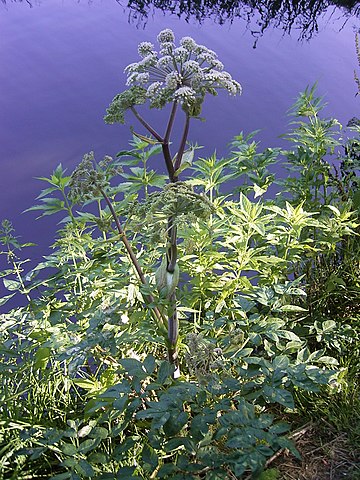Common Names and Other Names:
- Angelica
- Garden Angelica
- Wild Celery
- Norwegian Angelica
- Archangelica
Where Does It Occur:
Angelica is native to:
- Northern Europe
- Iceland
- Greenland
It is also found in cooler, damp regions of:
- Asia
- Europe, particularly in the northern parts
Angelica thrives in:
- Moist, fertile soils
- Riverbanks
- Woodlands
Basic Ingredients (Constituents):
Angelica contains a range of bioactive compounds:
- Volatile Oils:
- Composed of compounds like beta-phellandrene, alpha-pinene, and limonene
- Coumarins:
- Including bergapten, umbelliferone, and osthol
- Flavonoids:
- Known for their antioxidant properties
- Terpenes:
- Which contribute to the plant’s distinct aroma and therapeutic effects
- Lignans
- Furanocoumarins
- Polysaccharides:
- Beneficial for immune support
Most Commonly Used For Treatment Of:
- Digestive Health:
- Helps relieve indigestion, gas, and bloating
- Stimulates appetite
- Respiratory Conditions:
- Used as an expectorant for coughs and colds
- Helps clear congestion
- Circulatory Issues:
- Promotes blood circulation and helps with fatigue
- Rheumatic Conditions:
- Used for its anti-inflammatory properties to relieve pain and swelling
- Women’s Health:
- Traditionally used to ease menstrual cramps and regulate menstrual cycles
Side Effects:
While Angelica is beneficial for many health conditions, it should be used with caution:
- Photosensitivity:
- Some compounds, particularly furanocoumarins, can cause skin sensitivity to sunlight, leading to sunburn or dermatitis.
- Blood Thinning:
- May increase the risk of bleeding, especially in individuals taking anticoagulant medications.
- Pregnancy and Breastfeeding:
- Not recommended for pregnant women as it may stimulate the uterus.
- The safety in breastfeeding is not established.
Available Forms in the Market:
- Dried Root:
- Used in teas, decoctions, and as a spice in cooking.
- Essential Oil:
- Used in aromatherapy and topical applications for its soothing effects.
- Tinctures:
- Commonly used for digestive and respiratory support.
- Fresh Plant:
- Leaves and stems are used in culinary applications, particularly in Scandinavian cuisine.
- Capsules and Tablets:
- Contain dried, powdered angelica for convenience.
Research and Results:
- Anti-inflammatory and Immunomodulatory Effects:
- Studies have shown that angelica extracts can modulate immune responses and reduce inflammation.
- Digestive Health:
- Clinical research supports its use in treating symptoms of indigestion and bloating.
- Antioxidant Properties:
- The flavonoids in angelica have been studied for their antioxidant capacity, which is crucial in preventing oxidative stress.
Precautions:
- Medication Interactions:
- Individuals on blood thinners should use angelica with caution due to its potential anticoagulant effects.
- Sun Exposure:
- Avoid excessive sun exposure if using angelica products that may cause photosensitivity.
- Surgical Procedures:
- Discontinue use of angelica at least two weeks before scheduled surgery due to potential effects on blood clotting.
Conclusion:
Angelica archangelica is a versatile herb with a rich history in herbal medicine, valued for its support of digestive, respiratory, and circulatory health. However, due to its potent bioactive components, it should be used under the guidance of a healthcare professional to avoid potential side effects and interactions.
Disclaimer:
This information is for educational purposes only and should not replace professional medical advice. Always consult with a healthcare professional before starting any new treatment, especially those involving potent herbs like angelica.
« Back to Glossary Index